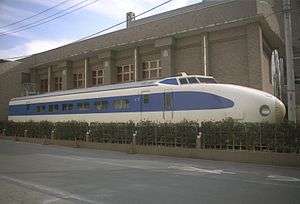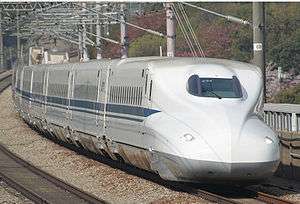Class 951 Shinkansen
The Class 951 (951形) was an experimental Japanese Shinkansen train built to test the technology for future high-speed trains operating at speeds of up to 250 km/h (155 mph) following the opening of the Tokaido Shinkansen in 1964.[1][2]
| Class 951 | |
|---|---|
 951-1 preserved in Kokubunji, Tokyo, November 1997 | |
| In service | 1969–1973 |
| Manufacturer | Kawasaki Sharyo, Nippon Sharyo |
| Constructed | 1969 |
| Scrapped | 2008 |
| Number built | 2 vehicles |
| Number preserved | 1 vehicle |
| Number scrapped | 1 vehicle |
| Formation | 2 cars |
| Capacity | 40 seated (Car 951-1) 50 seated (Car 951-2) |
| Operator(s) | JNR |
| Specifications | |
| Car body construction | Aluminium alloy |
| Car length | 25,000 mm (82 ft 0.25 in)[1] |
| Width | 3,386 mm (11 ft 1.31 in) |
| Doors | 2 sliding doors per side |
| Maximum speed | 250 km/h (155 mph) (nominal) |
| Traction system | 250 kW (340 hp) x 8 |
| Power output | 2,000 kW (2,700 hp) |
| Electric system(s) | 25 kV AC, 60 Hz overhead catenary |
| Current collection method | Cross-arm type pantograph |
| Track gauge | 1,435 mm (4 ft 8 1⁄2 in) standard gauge |
Formation
The Class 951 train was a two-car unit formed of cars numbered 951-1 and 951-2. Car 951-1 was built by Kawasaki Sharyo (present-day Kawasaki Heavy Industries), and had a seating capacity of 40 with seats arranged 3+2 abreast. Car 951-2 was built by Nippon Sharyo, and had a seating capacity of 50, also with seats arranged 3+2 abreast.[1]
- 951-1 (Mc)
- 951-2 (M'c)
Both cars were fitted with a cross-arm type pantograph at the inner end.[1] Both were based on the PS200 type used on the 0 Series Shinkansen trains, but the pantograph on car 951-1 was designated PS9010K, and that on car 951-2 was designated PS-1010A.[1] Normally, only the pantograph on car 951-2 was used.[1]
History
The train was unveiled to the press on 26 March 1969, with formal test running commencing on the Tōkaidō Shinkansen from 2 July 1969.[3]
On 24 February 1972, the Class 951 recorded a world speed record of 286 km/h (178 mph) on the Sanyo Shinkansen between Himeji and Nishi-Akashi, breaking the previous record of 256 km/h (159 mph) set by the Class 1000 Shinkansen.[1]
The train was formally withdrawn on 11 April 1980.[4] Car 951-2 was transferred to the Railway Technical Research Institute in Kokubunji, Tokyo, where it was used for roller rig testing. Car 951-1 was donated to the nearby Hikari Plaza Community Centre in 1994, where it is open to the public.[5] Car 951-2 was subsequently stored out of use inside the Railway Technical Research Institute,[1] and was cut up in 2008.[4]
References
- プロトタイプの世界 - Prototype World. Japan: Kōtsū Shimbunsha. December 2005. OCLC 170056962.
- "新幹線試験電車" [Shinkansen Experimental Train]. Japan Railfan Magazine. Vol. 9 no. 91. Japan: Koyusha Co., Ltd. January 1969. pp. 8–10.
- Suda, Hiroshi (2000). 東海道新幹線 [Tokaido Shinkansen]. Tokyo, Japan: JTB Can Books. ISBN 4-533-03563-9.
- Minoru, Saiki (April 2014). 首都圏こだわりレイルビュー 第13回孤高の保存車両 [Tokyo Area Rail View Part 13: Unique Preserved Rolling Stock]. Tetsudō Daiya Jōhō Magazine (in Japanese). Vol. 43 no. 360. Japan: Kōtsū Shimbun. pp. 90–92.
- 鉄道のテクノロジーVol1:新幹線 [Railway Technology Vol.1: Shinkansen]. Japan: Sanei Mook. April 2009. p. 121. ISBN 978-4-7796-0534-5.
External links
| Wikimedia Commons has media related to Class 951 Shinkansen. |
- Kokubunji Hikari Plaza information (in Japanese)

